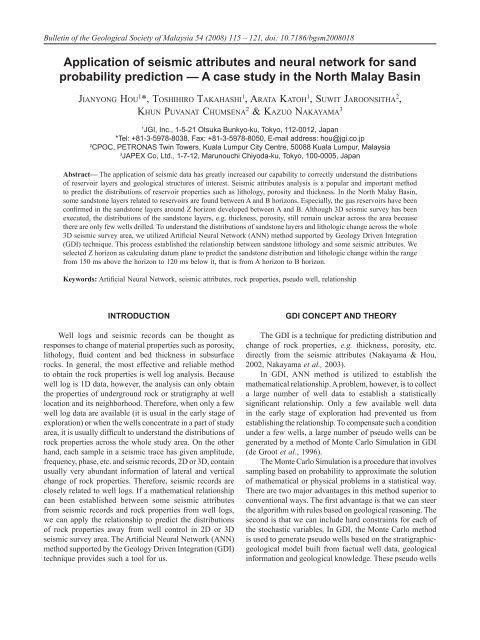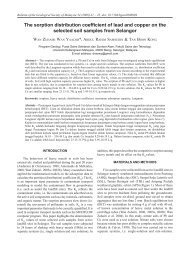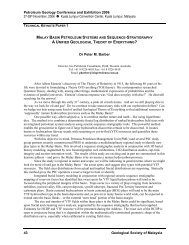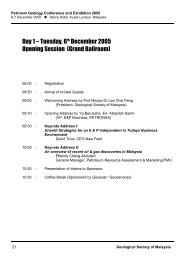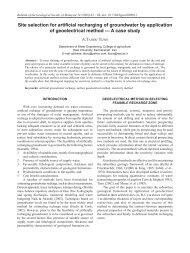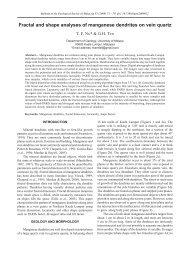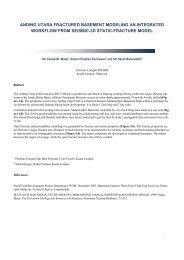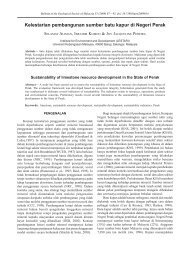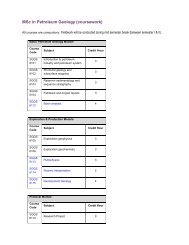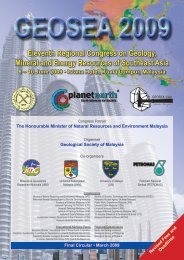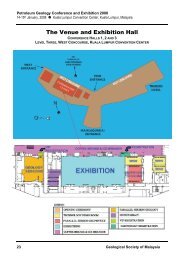Application of seismic attributes and neural network for sand ...
Application of seismic attributes and neural network for sand ...
Application of seismic attributes and neural network for sand ...
- No tags were found...
Create successful ePaper yourself
Turn your PDF publications into a flip-book with our unique Google optimized e-Paper software.
Bulletin <strong>of</strong> the Geological Society <strong>of</strong> Malaysia 54 (2008) 115 – 121, doi: 10.7186/bgsm2008018<strong>Application</strong> <strong>of</strong> <strong>seismic</strong> <strong>attributes</strong> <strong>and</strong> <strong>neural</strong> <strong>network</strong> <strong>for</strong> s<strong>and</strong>probability prediction — A case study in the North Malay BasinJi a n y o n g Ho u 1 *, To s h i h i r o Ta k a h a s h i 1 , Ar at a Kat o h 1 , Su w it Ja r o o n s i t h a 2 ,Kh u n Pu va n at Ch u m s e n a 2 & Ka z u o Na k aya m a 31JGI, Inc., 1-5-21 Otsuka Bunkyo-ku, Tokyo, 112-0012, Japan*Tel: +81-3-5978-8038, Fax: +81-3-5978-8050, E-mail address: hou@jgi.co.jp2CPOC, PETRONAS Twin Towers, Kuala Lumpur City Centre, 50088 Kuala Lumpur, Malaysia3JAPEX Co, Ltd., 1-7-12, Marunouchi Chiyoda-ku, Tokyo, 100-0005, JapanAbstract— The application <strong>of</strong> <strong>seismic</strong> data has greatly increased our capability to correctly underst<strong>and</strong> the distributions<strong>of</strong> reservoir layers <strong>and</strong> geological structures <strong>of</strong> interest. Seismic <strong>attributes</strong> analysis is a popular <strong>and</strong> important methodto predict the distributions <strong>of</strong> reservoir properties such as lithology, porosity <strong>and</strong> thickness. In the North Malay Basin,some s<strong>and</strong>stone layers related to reservoirs are found between A <strong>and</strong> B horizons. Especially, the gas reservoirs have beenconfirmed in the s<strong>and</strong>stone layers around Z horizon developed between A <strong>and</strong> B. Although 3D <strong>seismic</strong> survey has beenexecuted, the distributions <strong>of</strong> the s<strong>and</strong>stone layers, e.g. thickness, porosity, still remain unclear across the area becausethere are only few wells drilled. To underst<strong>and</strong> the distributions <strong>of</strong> s<strong>and</strong>stone layers <strong>and</strong> lithologic change across the whole3D <strong>seismic</strong> survey area, we utilized Artificial Neural Network (ANN) method supported by Geology Driven Integration(GDI) technique. This process established the relationship between s<strong>and</strong>stone lithology <strong>and</strong> some <strong>seismic</strong> <strong>attributes</strong>. Weselected Z horizon as calculating datum plane to predict the s<strong>and</strong>stone distribution <strong>and</strong> lithologic change within the rangefrom 150 ms above the horizon to 120 ms below it, that is from A horizon to B horizon.Keywords: Artificial Neural Network, <strong>seismic</strong> <strong>attributes</strong>, rock properties, pseudo well, relationshipIntroductionWell logs <strong>and</strong> <strong>seismic</strong> records can be thought asresponses to change <strong>of</strong> material properties such as porosity,lithology, fluid content <strong>and</strong> bed thickness in subsurfacerocks. In general, the most effective <strong>and</strong> reliable methodto obtain the rock properties is well log analysis. Becausewell log is 1D data, however, the analysis can only obtainthe properties <strong>of</strong> underground rock or stratigraphy at welllocation <strong>and</strong> its neighborhood. There<strong>for</strong>e, when only a fewwell log data are available (it is usual in the early stage <strong>of</strong>exploration) or when the wells concentrate in a part <strong>of</strong> studyarea, it is usually difficult to underst<strong>and</strong> the distributions <strong>of</strong>rock properties across the whole study area. On the otherh<strong>and</strong>, each sample in a <strong>seismic</strong> trace has given amplitude,frequency, phase, etc. <strong>and</strong> <strong>seismic</strong> records, 2D or 3D, containusually very abundant in<strong>for</strong>mation <strong>of</strong> lateral <strong>and</strong> verticalchange <strong>of</strong> rock properties. There<strong>for</strong>e, <strong>seismic</strong> records areclosely related to well logs. If a mathematical relationshipcan been established between some <strong>seismic</strong> <strong>attributes</strong>from <strong>seismic</strong> records <strong>and</strong> rock properties from well logs,we can apply the relationship to predict the distributions<strong>of</strong> rock properties away from well control in 2D or 3D<strong>seismic</strong> survey area. The Artificial Neural Network (ANN)method supported by the Geology Driven Integration (GDI)technique provides such a tool <strong>for</strong> us.GDI concept <strong>and</strong> theoryThe GDI is a technique <strong>for</strong> predicting distribution <strong>and</strong>change <strong>of</strong> rock properties, e.g. thickness, porosity, etc.directly from the <strong>seismic</strong> <strong>attributes</strong> (Nakayama & Hou,2002, Nakayama et al., 2003).In GDI, ANN method is utilized to establish themathematical relationship. A problem, however, is to collecta large number <strong>of</strong> well data to establish a statisticallysignificant relationship. Only a few available well datain the early stage <strong>of</strong> exploration had prevented us fromestablishing the relationship. To compensate such a conditionunder a few wells, a large number <strong>of</strong> pseudo wells can begenerated by a method <strong>of</strong> Monte Carlo Simulation in GDI(de Groot et al., 1996).The Monte Carlo Simulation is a procedure that involvessampling based on probability to approximate the solution<strong>of</strong> mathematical or physical problems in a statistical way.There are two major advantages in this method superior toconventional ways. The first advantage is that we can steerthe algorithm with rules based on geological reasoning. Thesecond is that we can include hard constraints <strong>for</strong> each <strong>of</strong>the stochastic variables. In GDI, the Monte Carlo methodis used to generate pseudo wells based on the stratigraphicgeologicalmodel built from factual well data, geologicalin<strong>for</strong>mation <strong>and</strong> geological knowledge. These pseudo wells
Ap p l i c at i o n o f s e i s m ic at t r i bu t e s a n d n e u r a l n e t w o r k f o r s a n d p ro b a b i l it y p r e d ic t i o ncontrolled by the movement <strong>of</strong> normal faults, both pureextensional <strong>and</strong> transpressional tectonics. The extensionaltectonics during Oligocene <strong>and</strong> Early Miocene causedtilted fault blocks, horst <strong>and</strong> graben features <strong>and</strong> anticlinalfeatures against faults (Figure 2). The trap style is mainlyfault dependent while widespread marine shales provide agood regional top seal. The intra<strong>for</strong>mational shale in theprospective sequence also provides a very good top seal<strong>for</strong> individual reservoir package. In the study area, somes<strong>and</strong>stone layers with reservoirs property are found betweenA <strong>and</strong> B horizons, <strong>and</strong> main reservoir is Z-s<strong>and</strong> betweenthem (Figure 3).<strong>Application</strong> <strong>of</strong> GDIUsually, the lithology in<strong>for</strong>mation can be obtained fromlog data. In our study area, however, it is difficult to get itbecause there are six available wells <strong>and</strong> only three amongthem can be used in the study. There<strong>for</strong>e, <strong>for</strong> underst<strong>and</strong>ingthe distributions <strong>of</strong> the s<strong>and</strong>stone layers between A <strong>and</strong> Bhorizons, the GDI technique is applied in the study area.a. Pseudo wellsTo predict the distribution <strong>of</strong> the s<strong>and</strong>stone usingthe <strong>seismic</strong> <strong>attributes</strong>, it is necessary to establish themathematical correlation, or relationship, between <strong>seismic</strong><strong>attributes</strong> <strong>and</strong> lithologic property. Obviously, it is difficultto establish the statistical relationship only by limited threefactual well data. To obtain enough lithologic samples,we need more well data. For this reason, a 1D simulationcalled the Monte Carlo Simulation is introduced to generatepseudo wells to compensate the lack <strong>of</strong> factual well data(de Groot et al., 1996).A geological model is first established by integratingvarious real geological data including well logs, geologicalin<strong>for</strong>mation <strong>and</strong> knowledge <strong>of</strong> the study area (Figure 4)be<strong>for</strong>e generating pseudo wells. In the geological model, thestratigraphic order, lithologic units <strong>and</strong> their properties inseveral <strong>for</strong>mations are defined <strong>and</strong> are attached with variouslog responses, <strong>and</strong> various lithologies are distinguishedfrom relative GR value. For sampling the problem, we onlydefine two kinds <strong>of</strong> lithologic units in every <strong>for</strong>mation unit,or s<strong>and</strong>stone <strong>and</strong> shale. Moreover, the s<strong>and</strong> <strong>and</strong> shale unitsare given a lothologic code respectively to distinguish <strong>and</strong>classify them with <strong>seismic</strong> <strong>attributes</strong>. That is, s<strong>and</strong> is definedas one (1) <strong>and</strong> shale as zero (0).To obtain enough well realizations, 200 pseudowells with varying stratigraphic frameworks <strong>and</strong> well logresponses are generated (Figure 5 left). In this simulation,the parameters <strong>of</strong> variables such as thickness <strong>of</strong> stratigraphicunits, porosity <strong>and</strong> various log responses <strong>of</strong> lithologic unitsare changed simultaneously <strong>and</strong> stochastically, based onthe statistics <strong>of</strong> the factual well data <strong>and</strong> given geologicalconstraints. Such pseudo wells have various log responses<strong>and</strong> are considered as similar to geological realities <strong>of</strong> thestudy area, <strong>and</strong> there<strong>for</strong>e, can be used as known samples <strong>of</strong>litholgic properties, but they have not location in<strong>for</strong>mation.Only purpose to generate pseudo wells is to compensate thelack <strong>of</strong> factual wells. There<strong>for</strong>e, the location in<strong>for</strong>mation isnot necessary in the simulation.The synthetic seismograms corresponding to the pseudowells can be constructed by convolving the reflectioncoefficient series with a zero-phase wavelet extracted fromthe real 3D <strong>seismic</strong> records (Figure 5 right). The pseudowells are an approach to lithologic properties <strong>of</strong> the studyarea, while the synthetic seismograms represent the feature<strong>of</strong> <strong>seismic</strong> <strong>attributes</strong>.b. Establishment <strong>of</strong> the mathematicalrelationship, utilizing ANNAs stated be<strong>for</strong>e, both well logs <strong>and</strong> <strong>seismic</strong> <strong>attributes</strong>may be considered as a response to various rock properties.We can obtain the rock properties, such as lithology,thickness, porosity, fluid-bearing character, etc. from factual<strong>and</strong>/or pseudo well logs, <strong>and</strong> <strong>seismic</strong> <strong>attributes</strong> from <strong>seismic</strong>records or from synthetic traces. Since the relationship isnot necessarily linear, the ANN method that recognizesnon-linear correlation is used in GDI analysis.We train the ANN by feeding some known samples<strong>of</strong> lithology <strong>and</strong> <strong>seismic</strong> <strong>attributes</strong> extracted from pseudowells <strong>and</strong> synthetic traces respectively into the ANN. Bythe training, the ANN can find a non-linear correlationGeological Society <strong>of</strong> Malaysia, Bulletin 54, November 2008Figure 3: Well correlation amongwells in the study area. Main s<strong>and</strong>reservoirs are found around Zhorizon.117
Ji a n yo n g Ho u, To s h ih i r o Ta k a h a s h i, Ar ata Kat o h , Su w it Ja r o o n s it h a, Kh u n Pu va n at Ch u m s e n a & Ka z u o Na k aya m aFigure 4: Geological-stratigraphic model established from realgeological in<strong>for</strong>mation including well logs, stratigraphic sequence,lithologic units <strong>and</strong> geological knowledge.between lithology <strong>and</strong> <strong>seismic</strong> <strong>attributes</strong>. In this study,used <strong>seismic</strong> <strong>attributes</strong>, called “Sample”, is a time series<strong>of</strong> amplitude values along a given <strong>seismic</strong> trace. In otherwords, it returns the amplitudes at the specified samplingpositions within a specified time windows (Figure 6). When“Sample” is extracted, the extracting sample rate, the timewindow length at every sampling <strong>and</strong> total sampling timewindow length are necessarily specified. In this case, thesampling rate is 2ms <strong>and</strong> the time window length at everysampling is defined from -20 ms to 20 ms referring tosampling position, while the total sampling time windowlength is from -150 ms to 120 ms referring to Z horizon(Figure 6), which corresponds approximately from A horizonto B horizon (Figure 3).There are several ANN models, but the Multi-layersperceptron model with the learning algorithm <strong>of</strong> backpropagationis used to establish the relationship betweenthe lithology codes <strong>and</strong> <strong>seismic</strong> <strong>attributes</strong> (Figure 7). Theadvantage <strong>of</strong> the model is that it can feed back the errorin<strong>for</strong>mation to input layer by comparing the calculated values(lithology property) by ANN with “actual” values extractedfrom wells (including factual <strong>and</strong>/or pseudo wells), <strong>and</strong> thenadjust automatically the weighting vectors interconnectingFigure 5: Part <strong>of</strong> pseudo wells (left)generated by Monte Carlo simulation <strong>and</strong>corresponding synthetic traces (right), basedon the geological-stratigraphic model.Figure 6: Lithology extraction from pseudowells <strong>and</strong> <strong>seismic</strong> <strong>attributes</strong> (Sample orAmplitude) from synthetic traces as knownsamples.118Geological Society <strong>of</strong> Malaysia, Bulletin 54, November 2008
Ap p l i c at i o n o f s e i s m ic at t r i bu t e s a n d n e u r a l n e t w o r k f o r s a n d p ro b a b i l it y p r e d ic t i o nFigure 7: The trained ANN (left) <strong>and</strong> its per<strong>for</strong>mances (right)<strong>for</strong> establishing the relationship between the lithologic code <strong>and</strong><strong>seismic</strong> <strong>attributes</strong>. Nodes are displayed in color scale relative totheir contribution to the output, i.e., from red (highest) , orange,yellow to white (lowest).Figure 8: A lithology cube created by applying the ANN to 3D<strong>seismic</strong> volume. It shows the distribution <strong>of</strong> s<strong>and</strong> probability fromA horizon to B horizon within the <strong>seismic</strong> volume.Figure 9: The distribution <strong>of</strong> s<strong>and</strong> probability on thehorizon slices with different time.Geological Society <strong>of</strong> Malaysia, Bulletin 54, November 2008119
Ji a n yo n g Ho u, To s h ih i r o Ta k a h a s h i, Ar ata Kat o h , Su w it Ja r o o n s it h a, Kh u n Pu va n at Ch u m s e n a & Ka z u o Na k aya m aadjacent layer so that the RMS errors can be decreased to aacceptable or reasonable level. According to the experiences,a RMS error below 0.8 is considered generally to bereasonable. The right lower figure in the Figure 7 showsthe decay <strong>of</strong> the calculative normalized RMS error duringtraining. The final error is about 0.8. Although it is a littlehigh, it is still thought in a reasonable range.Figure 10: S<strong>and</strong> distribution on the Z horizon slice.c. Prediction <strong>of</strong> distribution <strong>of</strong> s<strong>and</strong> probabilityThe trained ANN is applied to a 3D <strong>seismic</strong> volumein the North Malay Basin to predict the distribution <strong>of</strong>s<strong>and</strong> probability within the interval about from A horizonto B horizon.The Figure 8 is a lithology cube showing the distribution<strong>of</strong> s<strong>and</strong> probability in the specified interval <strong>of</strong> the 3D <strong>seismic</strong>survey. It is created by applying the trained ANN above to the3D <strong>seismic</strong> volume <strong>of</strong> the North Malay Basin. The Figure 9shows the distribution <strong>of</strong> s<strong>and</strong> probability on several horizonslices with different depth, which is generated parallel to theA horizon <strong>and</strong> each 20ms interval. From these illustrations onthe Figure 9, we can find there are little s<strong>and</strong> probability onsome horizon slices, e.g. A horizon+20 ms, A horizon+120ms <strong>and</strong> A horizon+160 ms, etc. This feature suggests somepredominant zones <strong>of</strong> shale or argillaceous rock around thesehorizon slices. Moreover, on the Z horizon slice (Figure10), the distribution <strong>of</strong> s<strong>and</strong> probability shows a channel<strong>and</strong> fan in shape. This feature may indicate the depositenvironment <strong>of</strong> s<strong>and</strong>stone. On the lithology sections alongInline or Crossline (Figure 8), the most <strong>of</strong> the high s<strong>and</strong>probability zones (red color) are observed in discontinuousdistributions. This may indicate that s<strong>and</strong>stone develops indiscontinuous s<strong>and</strong> body or lens.ConclusionsFigure 11: Comparison <strong>of</strong> predicted lithology by GDI with GRfrom factual well 1 at well locations.(Solid line: s<strong>and</strong> probability,Dotted line: GR).Figure 12: Comparison <strong>of</strong> predicted lithology by GDI with GRfrom factual well 2 at well locations.(Solid line: s<strong>and</strong> probability,Dotted line: GR).120The Geology Driven Integration Tool including theartificial <strong>neural</strong> <strong>network</strong> <strong>and</strong> Monte Carlo simulationtechniques is applied to the 3D <strong>seismic</strong> survey <strong>of</strong> the NorthMalay Basin to predict the distribution <strong>of</strong> s<strong>and</strong> probabilitywithin the main reservoir horizons. The predicted resultis checked with GR from factual wells (Figures 11a <strong>and</strong>11b). The check shows that the predicted result is consistentwith log features on the whole although there is error tosome extent.Using the <strong>seismic</strong> <strong>attributes</strong> <strong>and</strong> ANN technique isan effective method in the prediction <strong>of</strong> distributions <strong>of</strong>rock properties, especially when factual well data are fewor too concentrated so that it is difficult to underst<strong>and</strong> thedistributions by conventional methods.AcknowledgementsWe thank Carigali-PTTEP Operating Company Sdn.Bhd (CPOC) <strong>and</strong> Malaysia-Thail<strong>and</strong> Joint Authority (MTJA)<strong>for</strong> permission to publish this paper, which is based on thedata <strong>and</strong> in<strong>for</strong>mation <strong>of</strong> <strong>seismic</strong> <strong>and</strong> geology from a fieldsituated in the North Malay Basin.Geological Society <strong>of</strong> Malaysia, Bulletin 54, November 2008
Ap p l i c at i o n o f s e i s m ic at t r i bu t e s a n d n e u r a l n e t w o r k f o r s a n d p ro b a b i l it y p r e d ic t i o nReferencesDe Groot, P.F.M.,. Bril, A.H., Floris, F.J.T. <strong>and</strong> Campbell, A.E.1996, Monte Carlo simulation <strong>of</strong> wells, Geophysics, 61(3),631-638.Nakayama, K. <strong>and</strong> Hou, J., 2002, Prediction <strong>of</strong> ReservoirProperties by Monte Carlo Simulation <strong>and</strong> Artificial NeuralNetwork in the Exploration Stage. S<strong>of</strong>t Computing <strong>for</strong>Reservoir Characterization <strong>and</strong> Modeling. Edited by P.Wong,F.Aminzadeh <strong>and</strong> M.Nikravesh, pp. 15-33.Nakayama, K., Hou, J., Ohkawa, S. <strong>and</strong> Mitsuda, S. 2003, <strong>Application</strong><strong>of</strong> Geology Driven Integration Technique in the Prediction <strong>of</strong>Reservoir Distribution: An Example from the Japan Sea. Thepaper collection <strong>of</strong> the 9th Formation Evaluation Symposium<strong>of</strong> Japan, SPWLA.Rumelhart, D.E., Hinton, G.E. & Williams, R.J., 1986. Learninginternal representation by error propagation. In: Rumelhart, D.E. & McClell<strong>and</strong>, J. L. (eds.) Parallel Distributed Processing.Cambridge, MIT Press, pp. 318-362.Manuscript received 28 May 2008Revised manuscript received 25 November 2008Geological Society <strong>of</strong> Malaysia, Bulletin 54, November 2008121


